Top 7 Workflow Automation Examples to Boost Efficiency in 2025
In today's fast-paced business environment, manual tasks are more than just time-consuming; they're a direct bottleneck to growth. Repetitive data entry, endless email follow-ups, and disorganized content approvals don't just drain your team's energy. They actively stifle creativity and strategic thinking. This is precisely where workflow automation transforms the game. By setting up systems to handle these routine processes automatically, you can reclaim countless hours, minimize human error, and empower your team to focus on high-impact work.
This article dives deep into 7 practical workflow automation examples, providing a clear blueprint for streamlining your operations. We'll explore specific strategies and offer a detailed breakdown of how to replicate them for your own business. From managing social media campaigns with platforms like Publora to integrating complex enterprise systems, you'll get actionable insights to implement immediately. To truly embrace this transformation, exploring the top no-code automation tools can equip you with accessible platforms to build efficient workflows without extensive coding knowledge.
Each example in our list includes screenshots and direct links, helping you analyze the tactics behind each platform. Our goal is to give you a replicable guide to drive efficiency and scale your success.
1. Publora
Publora solidifies its position as a standout choice by offering a comprehensive and powerful suite of tools designed to streamline social media management from end to end. It's a game-changing platform for creators, agencies, and businesses looking to reclaim their time and amplify their online presence. By centralizing content planning, creation, and scheduling across more than eight major networks, Publora provides one of the most robust workflow automation examples available for social media.
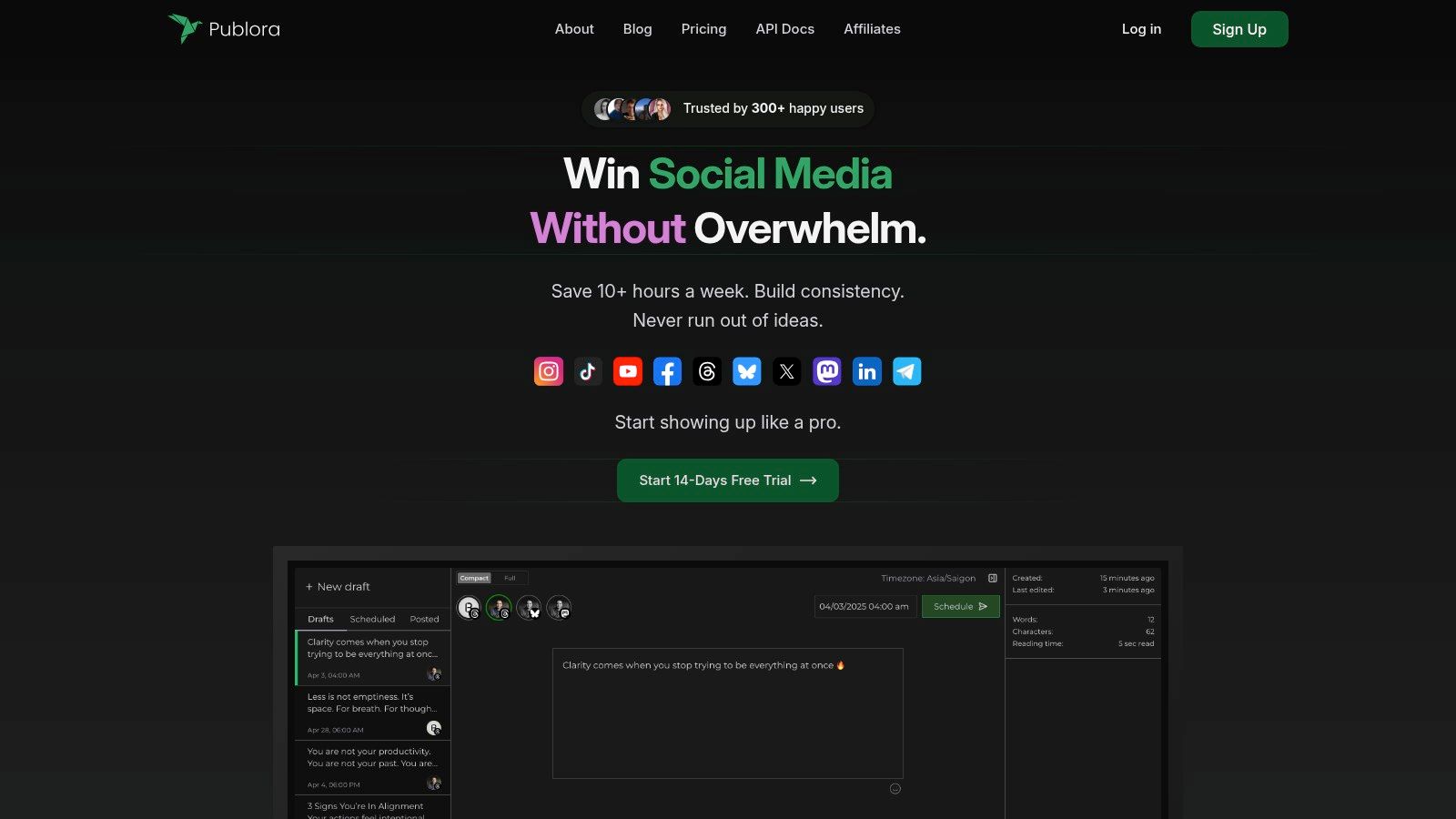
The platform’s core strength lies in its ability to transform a complex, time-consuming process into a simple, automated workflow. Users can manage everything from a single, intuitive dashboard, eliminating the need to juggle multiple apps and logins. This unified approach is especially beneficial for maintaining a consistent posting schedule, a key factor in boosting algorithm performance and audience trust.
Key Strengths and Strategic Advantages
What truly sets Publora apart is its intelligent automation. The built-in AI Editor and Idea Generator are not just simple assistants; they actively analyze your past content's performance to suggest new ideas and optimize posts for maximum engagement. This feature is a significant advantage, as it automates the creative and strategic aspects of content production, helping you overcome creative blocks and ensure every post is tailored for success on its specific platform, whether it’s a TikTok video, an Instagram Reel, or a thread on X.
For agencies and developers, Publora’s capabilities are particularly compelling.
- Agency-Ready Workspaces: Dedicated workspaces with granular permission controls allow agencies to manage multiple clients efficiently and securely.
- Developer-Friendly API: A powerful API and no-code integration options (like Zapier or Make) enable developers to build custom workflows, connect Publora with other business tools, and create highly specific automations.
Strategic Takeaway: Publora isn't just a scheduler; it's a complete content optimization and automation engine. Its AI-driven insights and multi-platform specialization provide a strategic edge, turning social media management from a reactive chore into a proactive growth strategy.
Practical Applications and Pricing
The platform is designed for immediate impact, with users reporting time savings of up to ten hours per week. Smart validations and email notifications act as a safety net, preventing publishing errors and ensuring you’re always aware of your content status.
Pros & Cons Analysis:
| Pros | Cons |
|---|---|
| Unified dashboard supports 8+ major social networks with platform-specific optimizations. | The maximum scheduling window is three months in advance without contacting support. |
| AI-powered editor and idea generator to overcome creative blocks and optimize content. | Video upload limits on lower-tier plans (e.g., 100MB on Starter) may be restrictive for some users. |
| Robust features for agencies, including client management and dedicated workspaces. | |
| Comprehensive API and no-code integration options for custom automation. |
Access and Pricing:
- Trial: A risk-free 14-day trial is available.
- Pricing: Flexible tiers start as low as $5.40/month, with plans that scale up to support unlimited accounts.
Publora offers an exceptional balance of power, simplicity, and affordability, making it an indispensable tool for anyone serious about mastering their social media workflow. For those interested in exploring similar tools, Publora has also published an excellent guide on the best social media automation tools to expand your knowledge.
Website: https://publora.com
2. ClickUp
ClickUp is a powerful all-in-one productivity platform that centralizes project management, tasks, documents, and chat into a single application. While it's known as a project management tool, its true strength for our purposes lies in its deep and customizable automation capabilities. ClickUp allows teams to build sophisticated, trigger-based workflows that eliminate manual, repetitive tasks, making it a cornerstone for efficient operations.
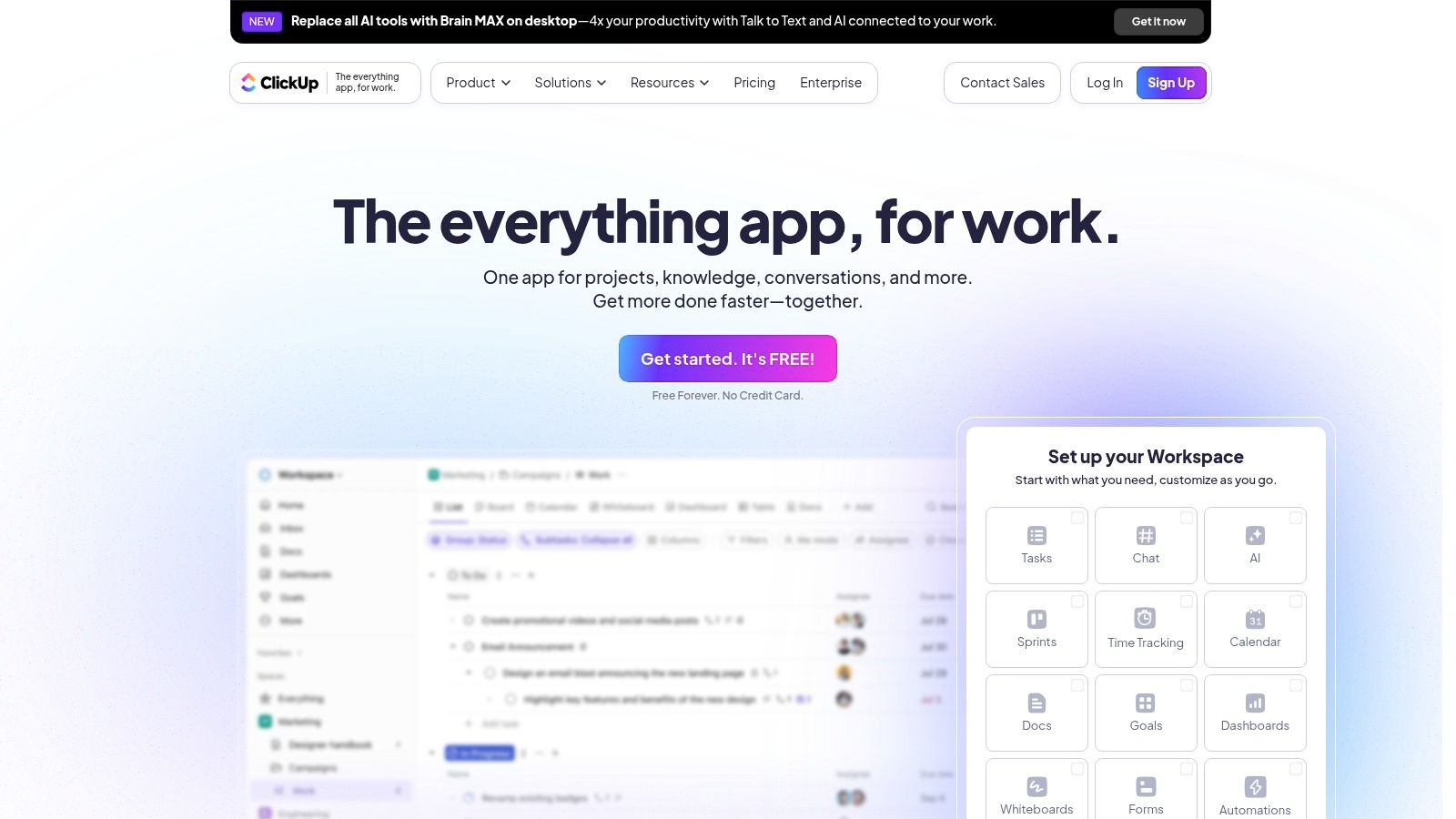
Unlike many platforms that offer rigid, pre-set automations, ClickUp provides a flexible “when this happens, then do that” builder. This makes creating intricate workflow automation examples simple, such as automatically assigning new social media post ideas to a content writer or changing a task's status when a due date approaches.
Strategic Breakdown & Insights
ClickUp excels at creating a structured content pipeline, a critical element often discussed in content workflow management. For social media managers, this means you can design a board where a new post idea automatically populates with a checklist for creation, review, and scheduling. As you move the post from "Idea" to "In Progress," ClickUp can automatically tag the graphic designer and copywriter.
Key Takeaway: The power of ClickUp is in its ability to connect multiple stages of a process without manual intervention. A task's status change can trigger a cascade of actions, from notifying stakeholders to applying a new template, ensuring nothing falls through the cracks.
How to Use ClickUp for Social Media Automation
- Content Calendar Automation: Create a "Content Calendar" list. Set up an automation so that when a task's status changes to "Ready to Publish," it automatically gets assigned to the social media manager with a due date for the following day.
- Integrate with Publora: Use ClickUp’s email integration. When you receive an analytics report from Publora, forward it to a specific ClickUp list. Set an automation to create a task from that email, assign it to your marketing analyst, and set a priority level to "Urgent" for immediate review.
- Approval Workflows: Use custom fields for "Approval Status." Create an automation that, when the status is changed to "Needs Review," automatically assigns the task to the marketing head and posts a comment tagging them for a final look.
Website: https://clickup.com/
3. Zapier
Zapier is the undisputed king of integration, acting as a universal translator between thousands of web applications. It allows you to connect over 5,000 different apps, creating automated workflows called "Zaps" without needing to write a single line of code. For businesses using a diverse tech stack, Zapier is the essential glue that binds disparate systems together, turning manual, multi-step processes into seamless, hands-off operations.
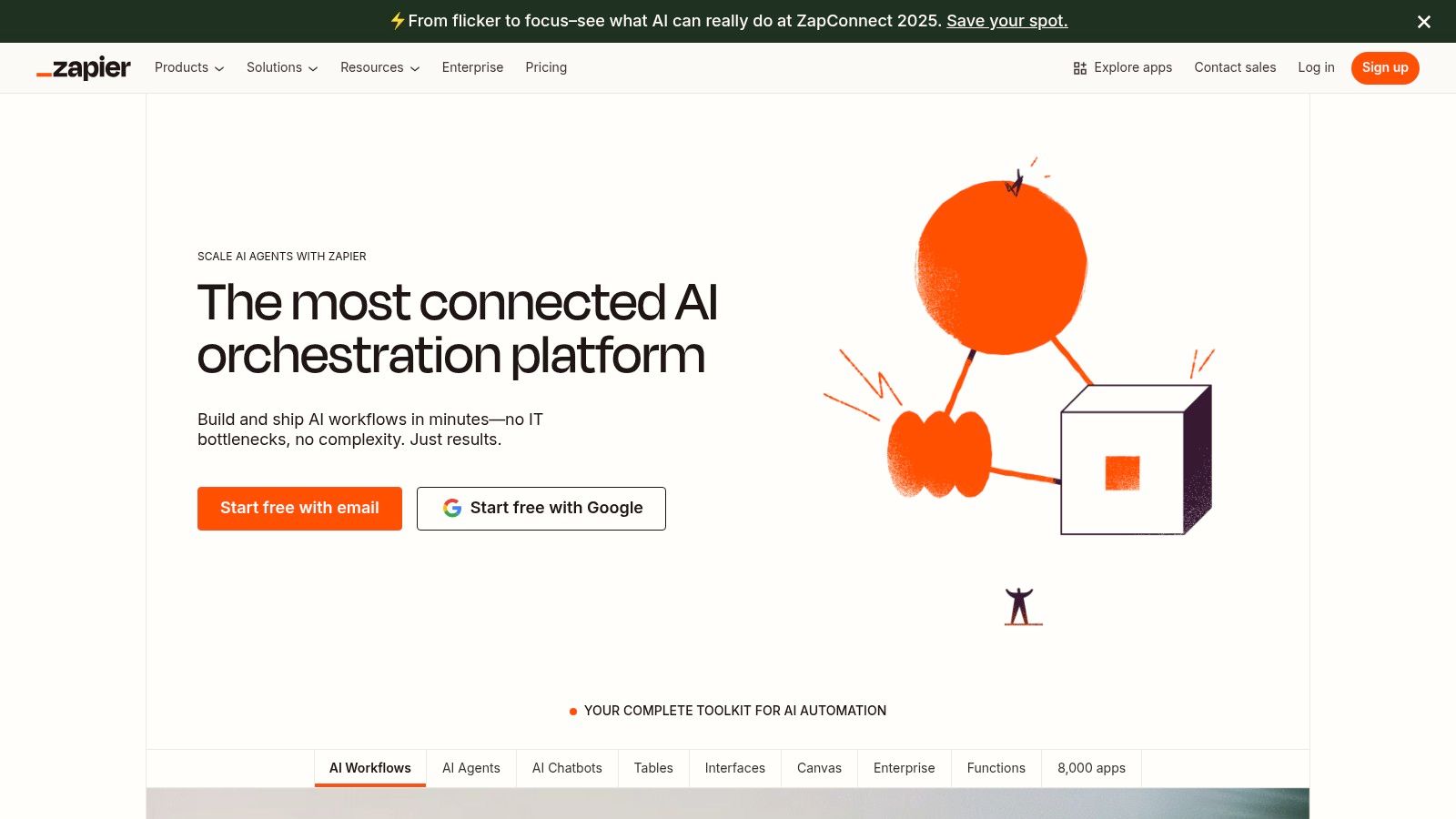
Unlike platform-native automations, Zapier's power comes from its neutrality and sheer breadth of connections. It specializes in cross-app automation, making it one of the most flexible workflow automation examples available. This means you can trigger an action in one app (like a new sale in Shopify) and have it kick off a sequence across several others (like adding the customer to Mailchimp and creating a task in Asana).
Strategic Breakdown & Insights
Zapier excels at bridging the gaps between your core social media tools and the rest of your business ecosystem. As one of the premier API integration platforms, it allows social media managers to sync their activities with sales, customer support, and project management tools. For example, a positive mention on Twitter can automatically create a lead in a CRM, or a new blog post going live can trigger a pre-written promotional post on multiple social channels.
Key Takeaway: Zapier's true value lies in its ability to create a unified data flow across your entire software stack. It prevents data silos and ensures that insights from one department are automatically shared and actioned in another, creating a truly connected and responsive organization.
How to Use Zapier for Social Media Automation
- Share Blog Posts Automatically: Create a Zap that triggers when a new item appears in your blog's RSS feed. Set the action to create a new post on your Facebook Page, LinkedIn profile, and Twitter account, automatically pulling the title and link.
- Sync Publora Mentions to Slack: Connect your Publora account to Slack. Create a Zap so that every time Publora detects a new mention of your brand, it sends a notification to a dedicated #social-mentions channel in Slack for your team to review in real-time.
- Build a Social Media Testimonial Database: Set up a Zap that monitors your brand's mentions on Twitter. Use a filter to only trigger for tweets with positive sentiment. Have Zapier automatically add the tweet's content and author to a new row in a Google Sheet, creating a running list of potential testimonials.
Website: https://zapier.com/
4. Kissflow
Kissflow is a comprehensive workflow automation platform that empowers businesses to design, implement, and manage workflows with minimal coding. It offers a low-code, drag-and-drop interface and an extensive library of pre-built templates, making it highly accessible for organizations looking to automate complex processes without deep technical expertise.
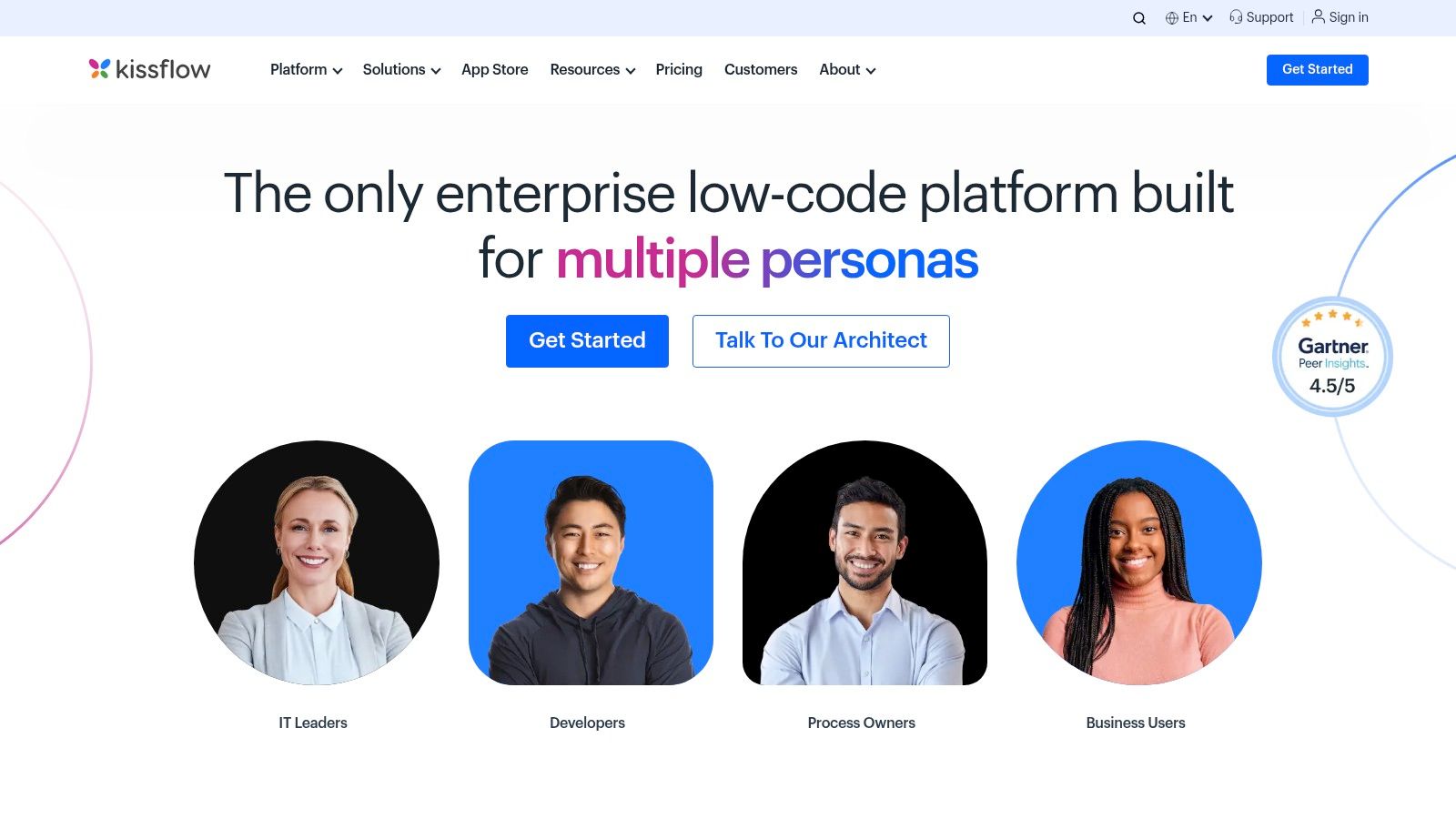
Unlike platforms focused solely on task management, Kissflow is built for end-to-end process management. This distinction makes it one of the more robust workflow automation examples for businesses that need to connect disparate departments. For instance, you can design a workflow that starts with a customer complaint on social media, triggers a ticket in the support system, and routes it to the appropriate product team for review, all within a single, unified process.
Strategic Breakdown & Insights
Kissflow excels at creating structured, multi-step approval and review processes that are crucial for maintaining brand consistency in social media marketing. Its strength lies in its ability to visualize and build complex conditional logic. For a social media team, this means you can build a workflow where a post about a new product feature automatically requires approval from legal, marketing, and product heads, while a simple holiday greeting post only needs a manager's sign-off. The real-time analytics also allow you to identify bottlenecks in your content pipeline.
Key Takeaway: Kissflow's power is its low-code environment for building truly cross-functional workflows. It moves beyond simple task automation to orchestrate entire business processes, ensuring compliance and efficiency from idea to execution.
How to Use Kissflow for Social Media Automation
- Multi-Level Content Approval: Use the visual workflow builder to design a content approval process. When a social media post is submitted, the workflow can automatically route it to the copy editor first, then the graphic designer for asset approval, and finally to the marketing manager for the final green light, sending notifications at each stage.
- Campaign Budget Management: Create a custom form in Kissflow for new social media campaign requests. Automate a workflow where submissions are sent to the finance department for budget approval. Once approved, the workflow can automatically create tasks for the social media team to begin execution.
- Integrate Publora Performance Data: Set up a process where a monthly performance report from Publora is uploaded to Kissflow. This can trigger a workflow that assigns a task to the marketing analyst to review the data, summarize key findings in a form, and then route those findings to leadership for a strategic review.
Website: https://kissflow.com/
5. Nintex
Nintex delivers an enterprise-grade workflow automation platform designed to transform complex business processes into streamlined digital workflows. It excels in handling intricate approval processes and compliance requirements, with strong integration into enterprise ecosystems like Microsoft and Salesforce. Its power lies in simplifying highly regulated or multi-step procedures, making it ideal for larger teams or agencies managing sensitive client content.
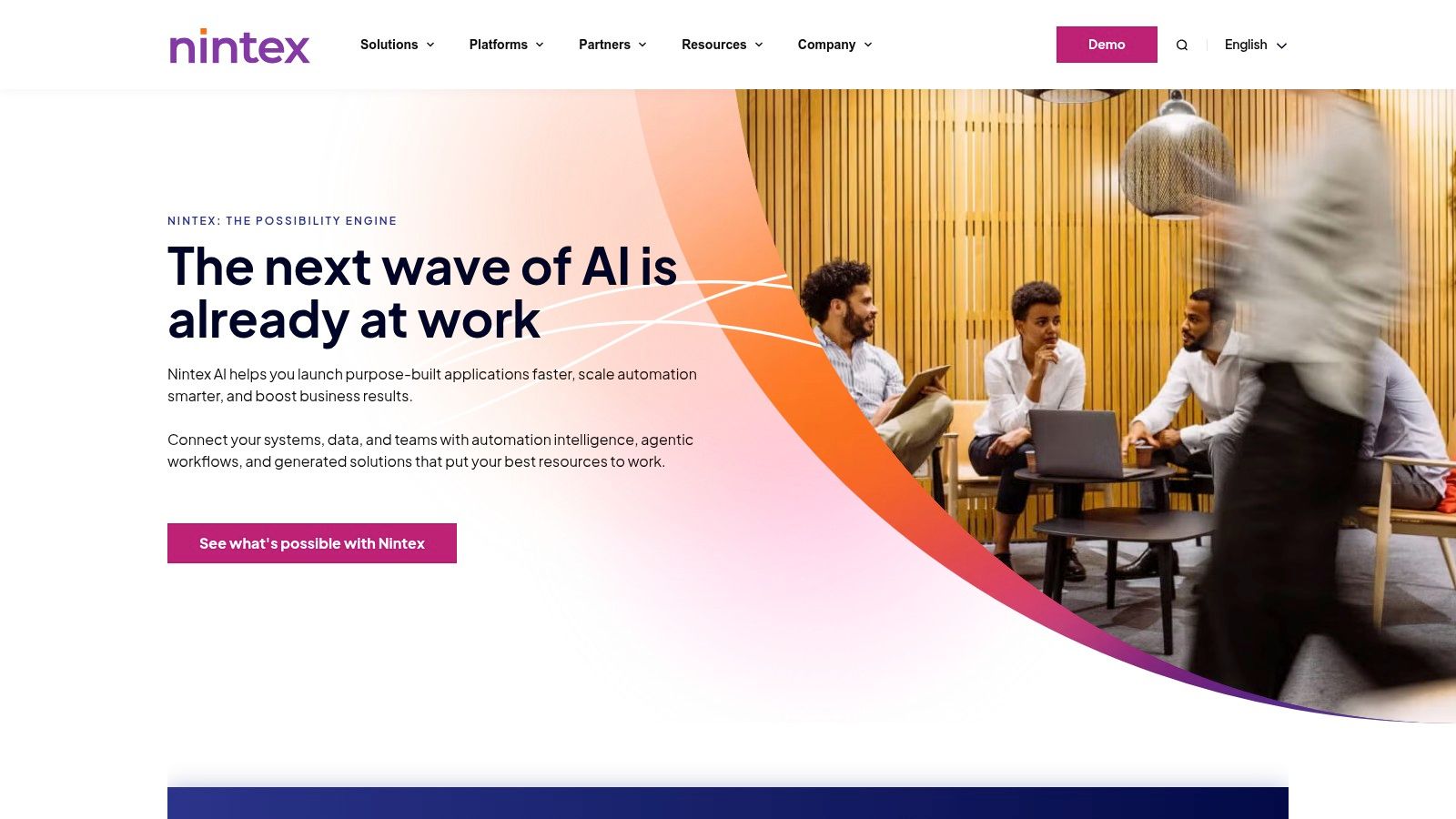
The platform is known for its user-friendly, drag-and-drop workflow designer, which allows users to map out and deploy sophisticated automation without needing to code. These detailed workflow automation examples can range from routing a social media campaign budget for multi-level approval to automatically generating a contract once a client gives the final sign-off on a campaign proposal.
Strategic Breakdown & Insights
Nintex stands out in its ability to manage compliance and governance within an automated workflow, a crucial factor for agencies working in regulated industries like finance or healthcare. For a social media context, this means you can build a workflow where a proposed post is automatically checked against a list of compliance keywords. If a flag is raised, the post is routed to the legal team for review before it can proceed.
Key Takeaway: Nintex is built for process intelligence and governance. It goes beyond simple task management to ensure that every step of a workflow adheres to predefined business rules and compliance standards, providing a full audit trail.
How to Use Nintex for Social Media Automation
- Compliance-Driven Approvals: Use the drag-and-drop designer to create an approval path. When a social media post is submitted, the workflow can automatically route it to the brand manager. Once approved, it then moves to the compliance officer for a final check before being marked as "Ready to Schedule."
- Integrate with Publora Reports: Connect Nintex with your email or cloud storage. When Publora generates a new campaign performance report, Nintex can trigger a workflow that extracts key metrics, populates them into a SharePoint list, and notifies the entire marketing team of the new data.
- Automated Content Archiving: Set up a workflow that automatically archives published social media content and its performance metrics. After a campaign concludes, Nintex can gather the post, comments, and engagement data, convert it into a PDF document, and store it in a designated folder for future reference and reporting.
Website: https://www.nintex.com/
6. Workato
Workato is a leading enterprise automation platform that empowers businesses to automate complex workflows across thousands of applications, databases, and systems. It acts as a powerful central nervous system for your tech stack, using AI-powered "recipes" (its term for automations) to connect everything from marketing platforms to sales CRMs and finance tools. For social media teams, Workato goes beyond simple task management to orchestrate sophisticated, multi-app processes.
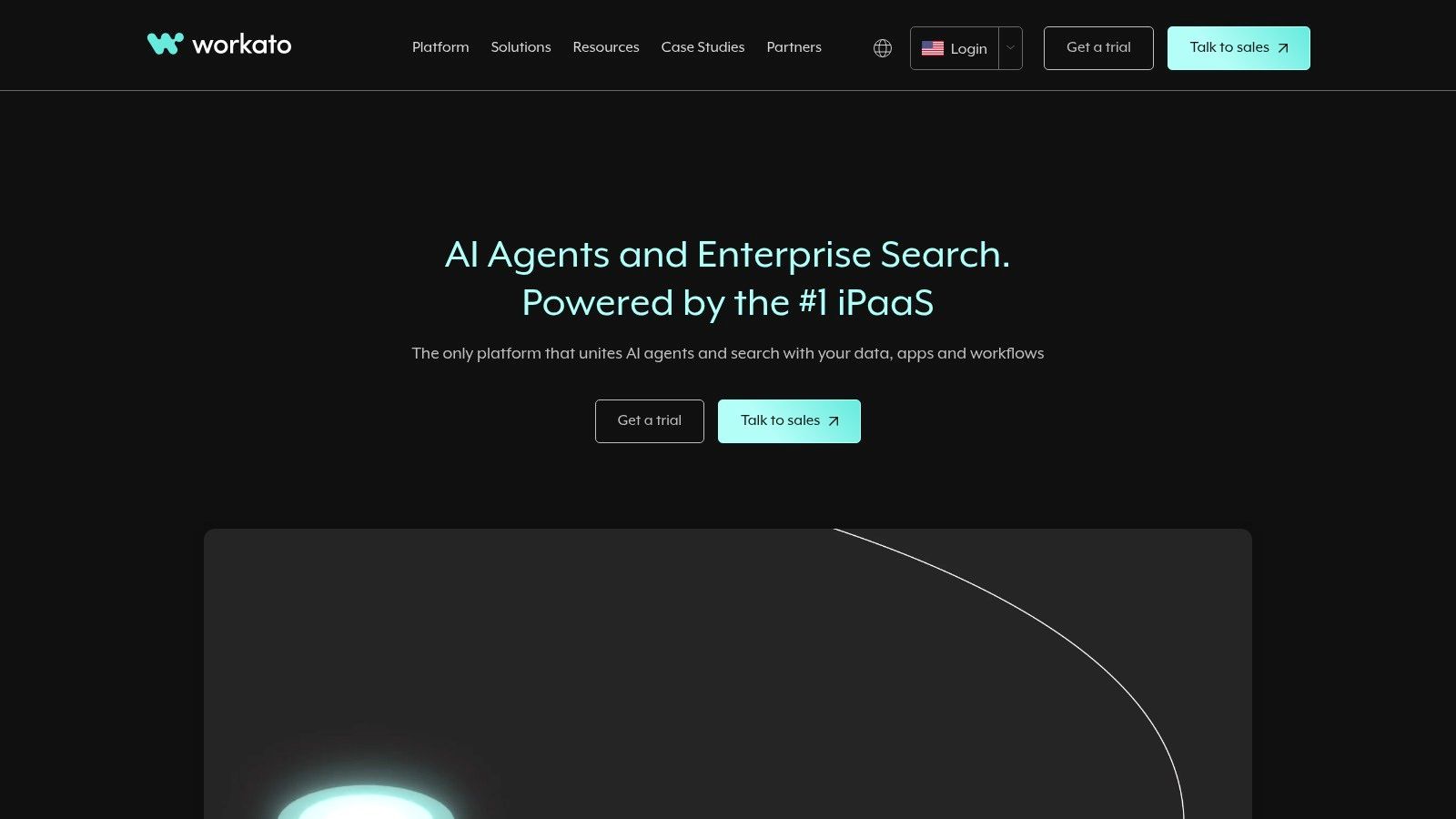
Unlike platforms focused on internal task automation, Workato specializes in deep, bi-directional integrations. This makes it one of the most powerful workflow automation examples for syncing data between disparate systems in real-time. For instance, you can automatically create a new lead in your CRM from a social media form submission and simultaneously add that contact to a specific email marketing sequence.
Strategic Breakdown & Insights
Workato's strength lies in its ability to handle enterprise-grade complexity with a low-code/no-code interface. This means social media managers can build automations that directly impact business revenue, such as linking social media engagement data to customer profiles in a CRM. This creates a unified customer view, allowing the sales team to see if a prospect recently interacted with a marketing campaign.
Key Takeaway: Workato excels at creating a closed-loop reporting system. It can pull performance data from social platforms, enrich it with sales data from a CRM, and push the final analysis into a business intelligence tool, all without manual data entry.
How to Use Workato for Social Media Automation
- Lead Generation Sync: Create a recipe that triggers when a new lead is captured via a LinkedIn Lead Gen Form. The recipe can automatically create a new contact in Salesforce, assign it to a sales rep based on territory, and send a Slack notification to the assigned rep with the lead’s details.
- Integrate with Publora: Use Workato to connect Publora's performance data to your wider business ecosystem. Create a recipe that, on a weekly basis, pulls your top-performing posts from Publora via an API or scheduled export, formats the data, and appends it to a Google Sheet or Power BI dashboard for trend analysis.
- Customer Support Workflow: Set up a recipe that monitors brand mentions on Twitter. When a tweet containing keywords like "issue" or "help" is detected, Workato can automatically create a support ticket in a platform like Zendesk or Jira, ensuring a rapid response from the customer service team.
Website: https://www.workato.com/
7. monday.com
monday.com is a powerful Work Operating System (Work OS) that excels in combining project management with intuitive, visual workflow automation. Known for its colorful and highly customizable interface, it enables teams to plan, track, and execute their work in one central hub. Its automation capabilities are designed to be user-friendly, allowing teams to eliminate manual work and connect processes seamlessly across departments.
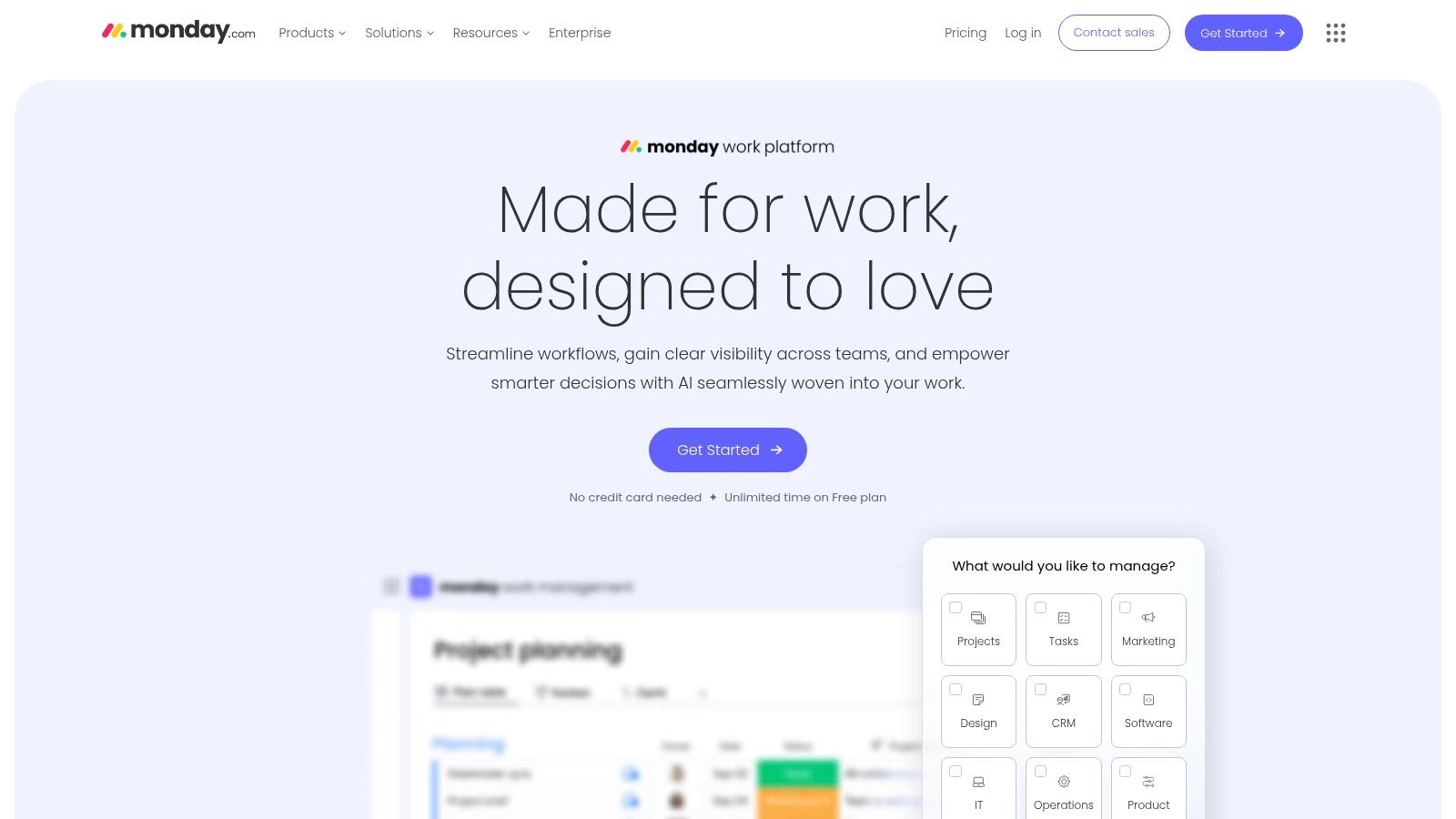
The platform uses a system of pre-built "recipes" that follow the "when this happens, then do that" logic, making it accessible even for non-technical users. These recipes are the building blocks for creating practical workflow automation examples, such as automatically notifying a team member in Slack when a task is assigned to them or moving an item to a different group when its status changes to "Complete."
Strategic Breakdown & Insights
monday.com's strength lies in its visual and cross-board automation capabilities, which are ideal for managing complex social media campaigns that involve multiple teams. For instance, you can link a "Content Creation" board with a "Campaign Performance" board. When a post is marked as "Published" on the first board, an automation can create a new item on the second board to track its metrics, ensuring a closed-loop reporting process.
Key Takeaway: monday.com makes it easy to visualize and connect disparate workflows. Its ability to trigger actions across different boards ensures that progress in one area, like content creation, automatically initiates tasks in another, like analytics and reporting.
How to Use monday.com for Social Media Automation
- Campaign Launch Sequence: On a "Campaign Planning" board, create a status column. Set an automation so when a campaign status changes to "Launch," it automatically creates a set of predefined tasks (e.g., "Post on Instagram," "Run Facebook Ad," "Send Newsletter") on your team's weekly task board.
- Automated Performance Updates: Integrate monday.com with your email. Set up a rule to forward weekly analytics reports from Publora to a specific monday.com board. Create an automation that parses the email subject to create a task titled "Review Weekly Performance," assigning it to your analyst and setting a due date.
- Cross-Functional Handoffs: Use cross-board automations for approvals. When a social media graphic on the "Design Team" board is set to "Ready for Review," automate an action that creates a linked item on the "Marketing Team" board, assigning it to the social media manager for final approval.
Website: https://monday.com/
Workflow Automation Tools Comparison
| Platform | Implementation Complexity 🔄 | Resource Requirements ⚡ | Expected Outcomes 📊 | Ideal Use Cases 💡 | Key Advantages ⭐ |
|---|---|---|---|---|---|
| Publora | Moderate; setup with several networks and AI tools | Low to moderate; API and no-code options reduce dev effort | High; boosts engagement, saves 10+ hrs/wk | Social media creators, agencies, SMBs | Unified dashboard, AI content optimization, multi-network support |
| ClickUp | Moderate; customizable but may need time to learn | Moderate; some advanced features require higher tiers | Improved productivity and workflow automation | Teams needing task and workflow management | 100+ automation templates, real-time collaboration |
| Zapier | Low; no coding needed, drag-and-drop builder | Low; largely user-driven with scalable pricing | Efficient multi-app automation, task reduction | Businesses integrating many apps | 5,000+ app integrations, easy workflow creation |
| Kissflow | Moderate; low-code but advanced customization possible | Moderate to high; pricing reflects scalability | Streamlined complex workflows with real-time analytics | Organizations automating business processes | Low-code design, pre-built templates, strong support |
| Nintex | High; enterprise-grade with complex workflows | High; designed for large businesses with advanced needs | Powerful automation for compliance and approvals | Enterprises needing complex compliance | Enterprise integrations, advanced document automation |
| Workato | Moderate to high; AI-powered but may require tuning | High; advanced security and multi-cloud deployment | Scalable real-time integrations, AI workflow suggestions | Large businesses requiring integrations | AI workflow suggestions, extensive connectors |
| monday.com | Moderate; visual builder but some plans limit features | Moderate; higher plans needed for full automation | Enhanced project tracking with automated workflows | Cross-team project and workflow management | Visual automation builder, strong integrations |
Your Next Step: From Examples to Implementation
Throughout this article, we've explored a diverse range of powerful workflow automation examples. We’ve seen how Publora streamlines social media content creation and distribution, how Zapier acts as a universal connector between your favorite apps, and how platforms like ClickUp and monday.com centralize project management into an automated powerhouse.
The core lesson from these examples is that automation is no longer a luxury reserved for large corporations. It's an accessible and essential strategy for businesses and creators of all sizes. The goal isn't just to save time; it's about eliminating tedious, repetitive tasks to free up your mental energy for high-impact activities like strategy, creativity, and customer engagement.
Key Takeaways and Actionable Insights
To move from inspiration to action, remember these key principles drawn from the examples we analyzed:
- Start with a Single Pain Point: Don't try to automate your entire business overnight. Identify one specific, recurring task that consumes your time or is prone to human error. Is it cross-posting content? Manually updating a project board? That’s your starting point.
- Match the Tool to the Task: A simple social media scheduling workflow doesn’t require an enterprise-level platform like Nintex. Conversely, a basic scheduler won't handle complex, multi-departmental approval processes. Use our list as a guide: for social media, start with Publora; for connecting disparate apps, look to Zapier or Workato; for project management, consider ClickUp or monday.com.
- Document Your Process First: Before you build an automation, map out the existing manual workflow. This crucial step reveals inefficiencies and helps you design a more logical and effective automated sequence. It ensures you're automating a good process, not cementing a bad one.
How to Choose Your First Automation Project
Choosing where to begin can feel overwhelming, but a simple framework can provide clarity. Look for tasks that are:
- High-Frequency: Things you do daily or weekly.
- Rule-Based: Processes that follow a consistent, predictable set of steps.
- Low-Complexity: Workflows that don't require nuanced human judgment at every stage.
By focusing on these criteria, you set yourself up for an early win. This initial success will build the confidence and momentum needed to tackle more ambitious workflow automation examples in the future. For those managing smaller teams and wanting a deeper dive into foundational strategies, this complete guide to workflow automation offers an extensive resource for streamlining your operations from the ground up.
The journey into automation is a marathon, not a sprint. The examples we've detailed prove that with the right tools and a strategic approach, you can build a smarter, more efficient system that works for you. Take the first step today, and begin building a future where your focus is on growth, not grind.
Ready to automate your social media workflow and reclaim your time? Publora is designed to simplify content scheduling, cross-posting, and audience engagement through powerful, easy-to-use automation. Sign up for Publora and turn the social media automation examples you've just read about into your new reality.
